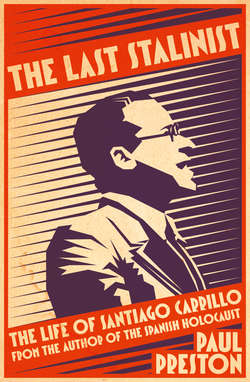Читать книгу The Last Stalinist: The Life of Santiago Carrillo - Paul Preston - Страница 7
PREFACE
ОглавлениеThis is the complex story of a man of great importance. From 1939 to 1975, the Spanish Communist Party (the Partido Comunista de España, or PCE) was the most determined opponent of the Franco regime. As its effective leader for two decades, Santiago Carrillo was arguably the dictator’s most consistent left-wing enemy. Whether Franco was concerned about the left-wing opposition is another question. However, the lack of a comparable figure in either the anarchist or Socialist movements means that the title belongs indisputably to Carrillo.
Carrillo’s was a life of markedly different and apparently contradictory phases. In the first half of his political career, in Spain and in exile, from the mid-1930s to the mid-1970s, Santiago Carrillo was admired by many on the left as a revolutionary and a pillar of the anti-Franco struggle and hated by others as a Stalinist gravedigger of the revolution. For many on the right, he was a monster to be vilified as a mass murderer for his activities during the Civil War. He came to prominence as a hot-headed leader of the Socialist Youth whose incendiary rhetoric contributed in no small measure to the revolutionary events of October 1934. After sixteen months in prison, he abandoned, and betrayed, the Socialist Party by taking its youth movement into the Communist Party. This ‘dowry’ and his unquestioning loyalty to Moscow were rewarded during the Civil War by rapid promotion within the Communist ranks. Not yet twenty-two years old, he became public order chief in the besieged Spanish capital and acquired enduring notoriety for his alleged role in the episodes known collectively as Paracuellos, the elimination of right-wing prisoners. After the war, he was a faithful apparatchik, who by dint of skill and ruthless ambition rose to the leadership of the Communist Party.
Then, in the course of the second half of his political career, from the mid-1970s until his death in 2012, he came to be seen as a national treasure because of his contribution to the restoration of democracy. From his return to Spain in 1976 until 1981, his skills, honed in the internal power struggles of the PCE, were applied in the national political arena. During the early years of the transition, it appeared as if the interests of the PCE coincided with those of the population. He would be canonized as a crucial pillar of Spanish democracy as a result of his moderation then. He was particularly lauded for his bravery on the night of 23 February 1981 when the Spanish parliament was seized as part of a failed military coup. After that time, his role reverted to that of Party leader and he was undone by generational conflict. Between 1981 and 1985, he presided over the destruction of the Communist Party, which he had spent forty years shaping in his own image. Accordingly, in later life and on his death, he was the object of many tributes and accolades from members of the Spanish establishment ranging from the King to right-wing heavyweights.
The chequered nature of Carrillo’s political career poses the question of whether he was simply a cynical and clever chameleon. In 1974, denying the existence of a personality cult within the PCE, he proclaimed: ‘I will never permit propaganda being made about myself.’1 Then, in an interview given two years later, he announced: ‘I will never write my memoirs because a politician cannot tell the truth.’2 He had already contradicted the first of these denials by dint of speeches and internal Party reports in which he constructed the myth of a selfless fighter for democracy. Then, in his last four decades, he propagated numerous accounts of his life in countless interviews, in more than ten of the many books that he wrote himself and in two others that he dictated.3 In this regard, he shared with Franco a dedication to the constant rewriting and improving of his own life story.
Accordingly, this account of a fascinating life differs significantly from the many versions produced by the man himself which are contrasted here with copious documentation and the interpretations of friends and enemies. There can be little here about Carrillo’s personal life. From the time that he entered employment at the printing works of the Socialist Party aged thirteen until his retirement from active politics in 1991, he seems not to have had much of one. Certainly, his life was dominated by his political activity, but he surrounded accounts about his existence outside politics with a web of contradictory statements and downright untruth.4 Despite his apparent gregariousness and loquacity, this is the story of a solitary man. One by one he turned on those who helped him: Largo Caballero, his father Wenceslao Carrillo, Segundo Serrano Poncela, Francisco Antón, Fernando Claudín, Jorge Semprún, Pilar Brabo, Manuel Azcárate, Ignacio Gallego – the list is very long. In his anxiety for advancement, he was always ready to betray or denounce comrades. Such ruthlessness was another characteristic that he shared with Franco. What will become clear is that Carrillo had certain qualities in abundance – a capacity for hard work, stamina and endurance, writing and oratorical skills, intelligence and cunning. Unfortunately, what will become equally clear is that honesty and loyalty were not among them.
